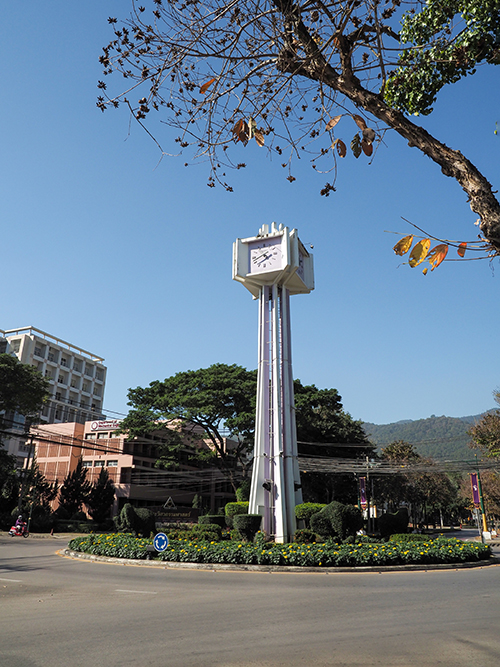One of Chiang Mai University’s most recognisable landmarks is the clock tower which stands in the middle of a roundabout with Doi Suthep mountain as its backdrop.
Chiang Mai University’s ‘Baby Elephants’, students and graduates alike, feel a sense of homecoming when driving past the famous clock tower, though few know much about its origins. There may be questions about the clock tower’s mechanics, its design, its history, even the many ghost stories associated with it…and it is now time to provide some answers.
Mystery 1: When was it built?
In 1979 a copy was made of an architectural rendering of the proposed tower featuring both the frontage and diagonal aspects of the tower. Importantly, the copy was signed by Marvin Youthhapinyo on the 16th July 1979.
From the above document it could be surmised that the clock tower was built in 1979, however, according to Professor Dr. Yongyuth Sajjavanich, President of the University at the time, the tower was in fact built in 1976 during his time as president. In his autobiography book, he wrote:
“One day I invited the manager of Phra Nakuru Construction for a meeting and told him that since the company had already constructed numerous buildings across the new campus, we would like them to also build our clock tower. The request was for the tower to be built for free. The university then wrote to a very large clock company, asking them to donate the clocks for the tower, explaining that it would also be good advertisement, to which they agreed. The inception of the the clock tower was therefore in 1976.”
The question as to the purpose of the 1979 copy of the architectural rendering has been raised. Professor Dr. Yongyuth Sajjavanich, who used to work in the university’s administrative building, clarified the matter by saying that the copy was drafted in order to calculate the cost of repairs in 1979, confirming that the tower itself was constructed in 1976. For nearly fifty years the clock tower, featuring four clocks, one on each face, stood elegant as an important landmark on Chiang Mai University’s campus.
Mystery 2: How does it work?
An old photo of the clock tower in its early days
A question many students have had over the years, is how the clocks function. According to Chatchai Osathaphan, ex head of the university’s finance division, who is also a collector of clocks, after having studied the history of the university’s clock tower he explained that the clocks are run off electricity, with batteries as a backup. Control of the sound levels and the clocks’ needles, including those of the entire system are in a box by the Women’s Dorm 6, a mere 50 metres away from the tower itself.
There was a time when the clocks would ring on the hour, but following complaints from some students in nearby dormitories, it was reduced to four times per day at 8 am, 12 pm, 1 pm and 6 pm. However, with wear and tear, the clock currently no longer rings.
The care for the clock tower falls under the watch of the security personnel of the university, whose job is to do their best to maintain and keep the clock running. While there are backup batteries, one of the main problems faced is when electricity shortages, sometimes upwards of six hours, and the batteries are unable to continue running the clocks. There is constant tuning of the clock, all of which can be done from the control box.
Mystery 3: Why are the clocks not synchronised?
Many people often question why the four clock faces are not synchronised, with the clock facing the Faculty of Engineering being notorious for lagging behind in time. The answer is simply that the control systems have loosened and are not functioning at optimum levels.
This problem is not as simple as that of a stopped clock due to the fact that it can not be solved in the control booth, but at the actual clock itself. The only way to access the four clocks is by crane truck, lifting a technician up to hammer in the core of the needles, while also cleaning the clock faces. Each time a crane truck is deployed, it must be borrowed from the municipality, adding to the challenge of the endeavour.
Mystery 4: Does the ladder lead all the way up to the clocks?

The observant will note the ladder which climbs up the tower between its columns. While this allows access to the inner workings of the clocks, it is not possible to reach any of the clock faces via the ladder itself; hence the crane. Over the years there have been numerous photographs circulated purportedly portraying people posing by a clock face; all of these are manufactured images.
Over the past nearly five decades, the clock tower has posed challenge to the young and adventurous, many of whom dare to climb it. According to Phisek Injai, head of the university security, this is a serious issue with many students attempting to climb the clock tower risking falling and electrocution. Those caught have their behaviour recorded and are sent to do community service.
Mystery 5: Is the clock tower ghost real?
While there are legends and superstitions about the ghost (pred) of the clock tower – purported to be as tall as the tower itself – this is a complete myth. For generations these stories have persisted, students passing on the legend that should one walk anti-clockwise three times around the tower and look through its columns, the ghost will appear. According to all security personnel over the years, none of them have seen such a ghost.
These historical facts and wild legends all make for a fascinating insight into the symbol that is so dear to so many generations of Baby Elephants who have graduated from the Chiang Mai University.